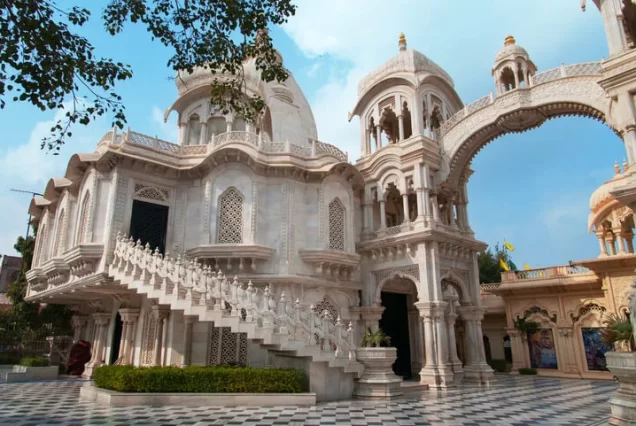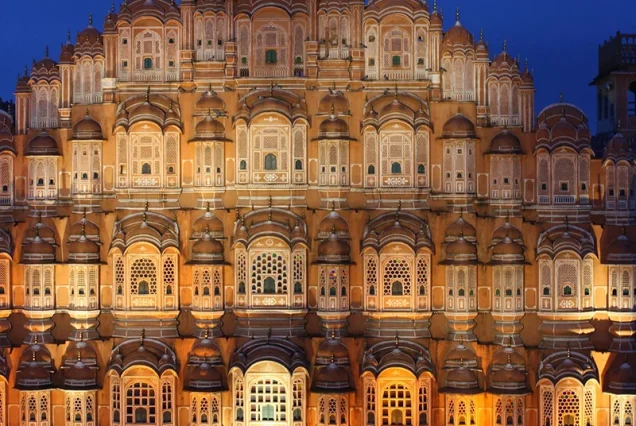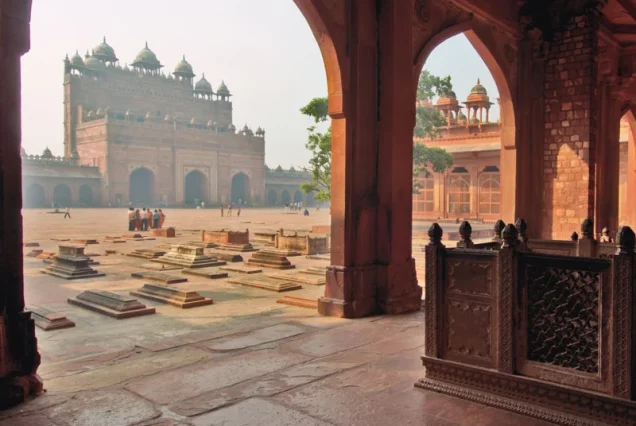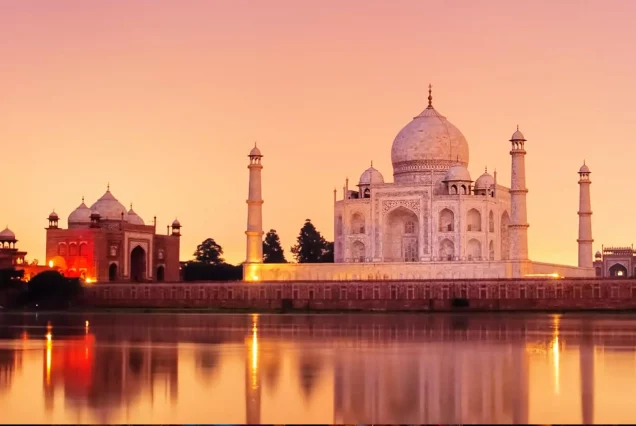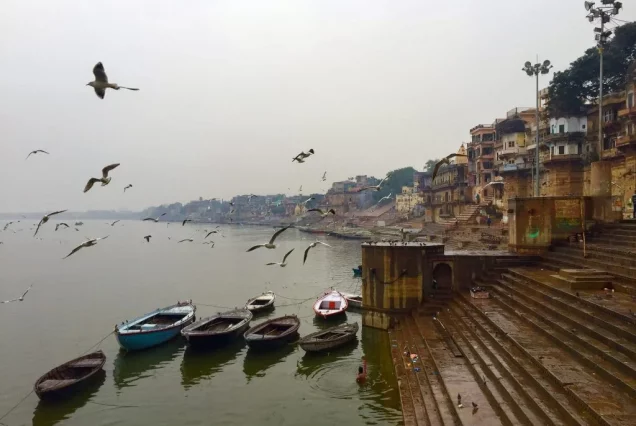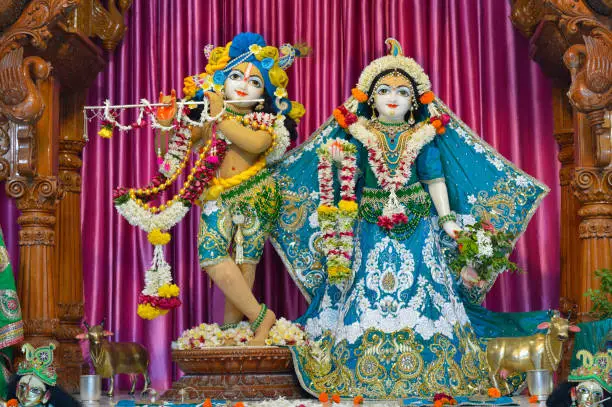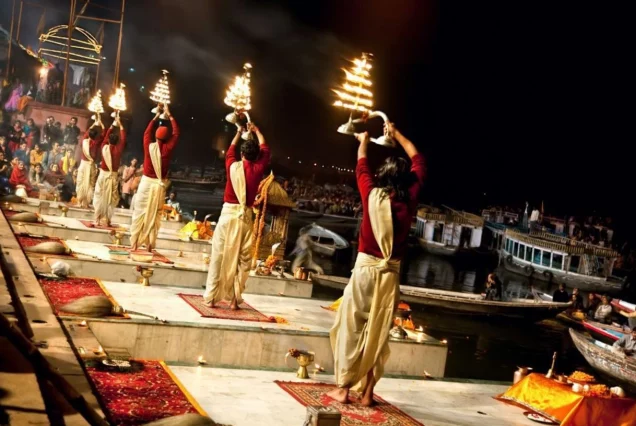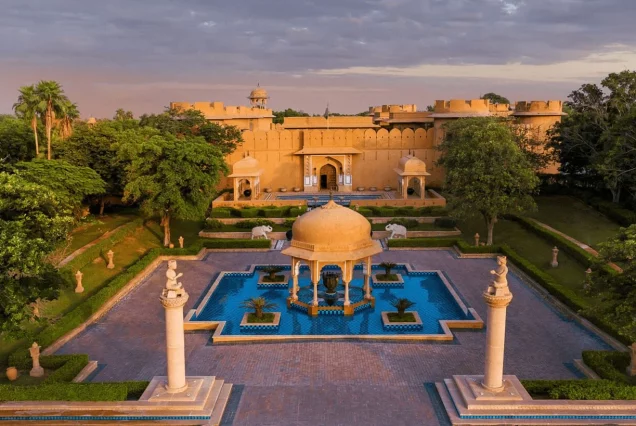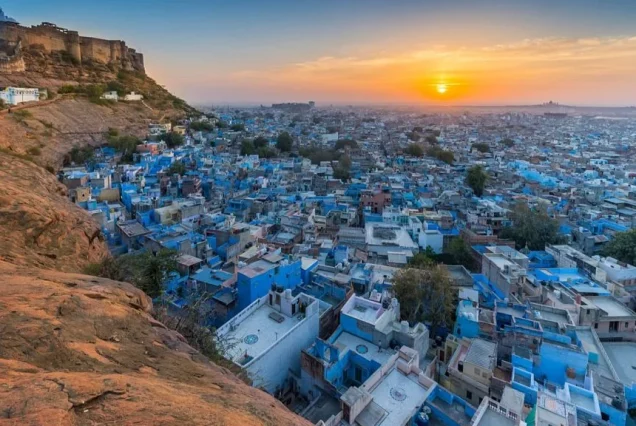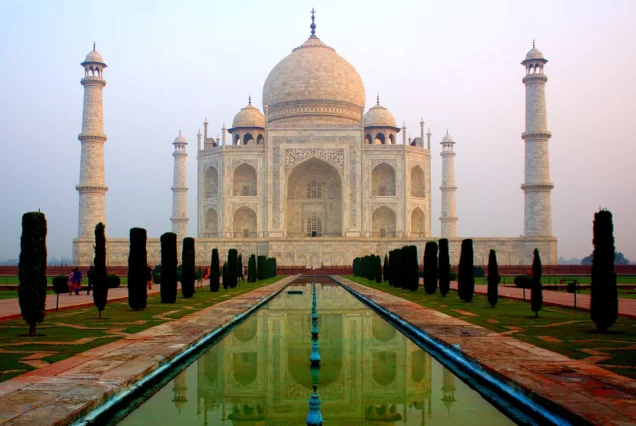Golden Triangle with Mathura and Vrindavan
India, the only country in the world where people from all religions live together with peace and harmony. This is because India has rich cultural and religious values which are inherited from elders to young ones and so on. It is said that in order to see the real and transparent life of a country then, it is always suggested to visit their temples, mosques, churches and other religious centers where the lessons of humanity and livelihood are spread to the followers. India is a land where people have great values and respect for these ancient temples and their ideology which people follow in their day-to-day life.
Golden Triangle Tour Package, one of the most asked and traveled tour circuits in India which is covered throughout the year by locals and international clients. While you explore this famous travel circuit, you have plenty of options to add to your travel itinerary along with the glittering palaces, massive forts, vibrant bazaars, spectacular monuments and mouth-watering cuisines. Golden Triangle Tour combines perfectly with the ancient city of Mathura and Vrindavan which are the two Holy cities for Hindu’s, situated on the banks of holy river Yamuna in the Indian state of Uttar Pradesh. Mathura and Vrindavan, have great influence on Hindu’s as these places are fully dedicated to Lord Krishna, a manifestation of Lord Vishnu. These places have many ancient temples which tell us the stories of Lord Krishna’s birth and his childhood so these places are highly travelled by locals throughout the year.
Custom Tours India, brings you the Golden Triangle tour with Mathura and Vrindavan where you will fall in love with the excellent ancient architecture, massive forts and palaces along with the twin cities of Mathura and Vrindavan. With this tour plan, you will get to know the significance of Lord Krishna’s lessons in Hindu’s life and amazing tales about his birth and miracles performed here by himself. Custom Tours India combines the famous Golden Triangle Tour with these holy cities so that you can get the perfect glimpse of ancient India with its monuments and temples.
Please go through the below suggested basic tour itinerary which you may consider if you wish to explore Golden Triangle Tour with Mathura and Vrindavan.
Golden Triangle Tour Packages with Mathura Vrindavan
| Day | Place | Summary |
|---|---|---|
| 1 | Delhi | Arrival |
| 2 | Delhi | Red Fort, Jama Masjid, Chandni Chowk, Qutub Minar, Humayun’s Tomb, India Gate, Parliament House |
| 3 | Delhi - Agra | Mehtab Bagh |
| 4 | Agra - Vrindavan | Taj Mahal, Rangji Temple, Nidhivan, Kashi Ghat, Radha Mohan Temple, Banke Bihari Temple, Prem Mandir |
| 5 | Mathura | Shri Krishna Janmbhumi, Dwarkadhish Temple |
| 6 | Jaipur | Hawa Mahal, Jal Mahal, Panna-Meena Kund, Amber Fort, City Palace, Jantar Mantar |
| 7 | Jaipur | Jaigarh Fort, Nahargarh Fort, GaltaJi Temple, Birla Temple |
| 8 | Jaipur - Delhi | Departure |
Day 1: Arrival at IGI Airport, New Delhi
After a warm welcome at IGI Airport, New Delhi, you will be escorted to your respective chauffer and vehicle by a representative of Custom Tours India. Post arrival, you will be transferred to your booked hotel where our representative will assist you with check-in.
Rest of the evening is free at leisure as you would be flying from a far distance.
Day 2: Local Sightseeing in Delhi
This day will be fully dedicated to the Mughal-era masterpieces of Delhi as we will take you out to explore this 5,000 years old city which has rich history and culture. This day, you will be introduced to an English-speaking tour guide who will explain the history and stories about each and every monument you will be exploring.
We will start our day by uncovering the gems of Old Delhi through visiting the ancient monuments and one of the oldest markets in Delhi.
- Jama Masjid –One of the best architectural examples of Mughals, Jama Masjid is inspired by Islamic and Persian architecture which was constructed by Mughal Emperor Shah Jahan in the year 1656 using the excellent rad sandstone and pure white marble. After climbing 121 stairs, we reach at an elevation of 10m and a huge courtyard which can accommodate 25,000 devotees at one time, renowned as the largest mosque in India.
Post Jama Masjid, we will go for a short Rikshaw Ride inside the oldest and busiest markets in Delhi, Chandni Chawk. This 1-hour experience will be there for the lifetime as you will be witnessing the daily life of local buyers and sellers and exchange of goods like spices, textiles, silk sarees, jewelry and many more commodities.
Post this, we will head towards the next monument which is a massive fort constructed almost 400 years earlier.
- Red Fort –Next stop will be another captivating Mughal architecture built entirely using red sandstone, hence the name “Red Fort”. Red Fort is one of the important historical monuments in India from where each year the country’s Prime Minister hosts a flag ceremony during “Independence Day”. Red Fort was constructed by Mughal Emperor Shah Jahan in 1638 establishing his new capital in Delhi from Agra. The massive fortress is spread over 255 acres and was the seat of power of Mughal for more than 200 years.
Post these two monuments of Old Delhi, we will head towards New Delhi where your tour guide will escort you to a few more important monuments of the city.
Here, we will pass through two other important building of New Delhi.
- India Gate – A memorial which was firstly built in the year 1921 British-Army for the brave soldiers who lost their lives during World War I. This excellent piece of art and sacrifice was designed by Sir Edwin Lutyens which was constructed using granite, yellow and red sandstone. Few years later, another structure was added to this monument named, Amar Jawan Jyoti. This structure was built to pay tribute to all the soldiers who fought fiercely during the Indo-Pakistan War of 1971.
- Parliament House – Post India Gate, on the opposite side of the monument is a massive government building, Rashtrapati Bhawan. This building is also known as “President’s House” as this is the official house of the President of India. This great building was constructed in the year 1931 and was designed by Sir Edwin Lutyens which was built as the “Seat of Power” for the British in Delhi. This massive building has 340 suite rooms for special guests, 37 fountains, several big courtyards, houses for both Lok Sabha and Rajya Sabha, Mughal Gardens and many more which makes this one of a kind.
Post these amazing sites, we will stop for lunch at one of the restaurants of the city where you can have the taste of Delhi’s cuisines and flavors. Don’t forget to end your lunch with hot Gulaab Jamuns mixed with vanilla ice-cream.
Post lunch, we will head for the remaining two monuments of the day which adds more charm and beauty to above Mughal architectures.
- Humayun’s Tomb –Known as “Monument of Love” as this monument was built by Empress Haji Begam for his loving husband, Mughal Emperor Jahangir as his final resting place. Humayun’s Tomb is India’s first garden tomb which was constructed in the year 1565 using red sandstone and the inner dome using white marble. The tomb is one of the best picturesque spots in Delhi with the backdrop of the tomb and lush green flower beds, fountains, pathways and similar water channels.
- Qutub Minar – First even Mughal architecture in Delhi which was commissioned by Qutub-Ud-Din-Aibak and later completed by his successors over the period of time. This historical monument of India was constructed in the year 1193 which is 73m tall and renowned as the tallest minaret in India. This minaret has 5 floors in which the first three floors are made up of red sandstone and the remaining two floors are built using pure white marble. The main attraction of this monument is the “Rust Resistance Iron Pillar” dated 2nd century built by Great Emperor Asoka.
Later, after completing all the above sightseeing places, we will mark this day as completed! Post these sites, if you wish to explore nightlife or wish to dine outside, please ask your driver.
Day 3: Drive to Agra and Local Sightseeing
This morning, enjoy your healthy breakfast at your wonderful hotel booked by Custom Tours India and then complete your check-out procedure as we will head towards our next destination – Agra, the city of Taj.
You will love your journey through the newly constructed Yamuna Expressway where you can see the rich agricultural side of this country as this expressway cuts its way through the long-stretched crop lands.
Post 3.5-hour drive, we will enter the city of Taj, Agra where we will head directly for lunch at one of the famous restaurants of the city. Post lunch, you will be transferred to your hotel where you can rest for a while.
Here, we will take you for a short tour which includes one of the most beautiful gardens of Agra which is considered the ideal place to view Taj from its backside with backdrop of holy river Yamuna.
- Mehtab Bagh – Last Garden out of eleven which was constructed by Mughal Emperor Babur along with the riverside in India. Mehtab Bagh was constructed in the 14th century and is also known as “Moonlight Garden” as this is the best place to admire the beauty of Taj, said by Mughal Emperor Shah Jahan, who constructed the world wonder – The Taj Mahal. The garden is beautifully laid out with similar pathways with shades of trees, fountains, flower beds and perfectly maintained lawns.
You may spend some time here on your own admiring the beauty of Taj Mahal built using finest white marble from Rajasthan.
Post this site, we will return back to the hotel and spend the rest of your evening at leisure.
Day 4: Taj Mahal and Drive to Vrindavan
This morning will be the best mornings of your life when you witness the majestic and fascinating Taj Mahal in front of you. We always recommend our clients to visit the Taj Mahal early in the morning before sunrise as this is the best time to view the Taj and we do have very less traffic.
So, here your English-speaking tour guide will meet you at your hotel lobby at 5:45am and then you will be taken to visit the Taj Mahal.
Please note that your tour guide known all the best points to take pictures, so he/she will assist you with beautiful pictures of you and the Taj Mahal.
- Taj Mahal – Majority of people in the world consider this beautiful building as “Symbol of Love”, Taj Mahal is one of the seven wonders of the world that was built by Mughal Emperor Shah Jahan in the loving memory of his favorite wife, Mumtaj Mahal in the year 1653. It took almost 22 years and the hands of 20,000 workers to build this marvelous unique monument. The monument consists of three main entry doors at the east, west and south corner whereas, the main mausoleum stands on a marble platform towards the northern end, facing its back towards the river Yamuna. Along with this, there are two symmetrical red sandstone buildings on each side of the main complex.
After admiring the beauty of this excellent architecture, head back to your hotel to relax for a while and breakfast. Post breakfast, complete your check-out procedure and then we will head towards the holy city of Vrindavan and Mathura.
Mathura and Vrindavan are the two holy cities which are also known as twin cities as this is the birthplace of Lord Krishna, the eighth incarnation of Lord Vishnu who came to earth during the Dvapara Yug (Hinduism) to fight the injustice and to support rightful Pandavasagainst their own ruthless cousins Kauravsduring the world’s longest battle as per Hinduism, the battle of Kurukshetra or the Mahabharata. There are a total number of 5,500 Hindu temples in Vrindavan!
On reaching Vrindavan, check-in at your hotel and rest for a while. Later in the evening, we will start our walking tour of this holy city of Vrindavan covering most of the famous temples of the city.
- Rangji Temple – Rangji Temple or Shree Ranganath Temple is one of the largest temples in North India which is dedicated to Lord GodaRanagamannar, incarnation of Lord Krishna. The temple is the replica of Ranaganathaswamy Temple of South India and was constructed in the year 1851. The main attraction of this temple is the sleeping idol of Lord Vishnu, mirror room, leela room where Lord Krishna’s childhood miracles are shown, Vehicle room – where all Lord Vishnu’s vehicles are showcased.
- Nidhivan – Nidhivan is a small place surrounded by lush green Tulsiplants and an unusual hollow tree where Lord Krishna is believed to come every night to perform Raas Leela. After the evening prayer, no one is allowed to stay inside the premises as in the midnight Lord Krishna comes where all the trees and plants gets converted into It is believed that, nearby houses hear the sounds of Krishna’s flute and Gungru’s. Along with this, every morning when priest goes inside, they see everything messed up like Radha’s decorative things, Lord Krishna’s bed, water glass is half empty and many more things which reflects that there is some different energy who comes in the midnight here. Also, there were instances when someone tries to sneak inside, gets badly harmed and some loses their eyesight.
- Kashi Ghat – Post completing these two pilgrim sites, we will take a short walk towards the Kashi Ghat where you can witness evening Aarti (Prayer) which is performed daily for holy river Yamuna. You can sit by the stairs and enjoy nature with the holy bells and prayers. If you wish you may opt to go for a short boat ride.
- Radha Mohan Temple – Radha Raman Temple is one of the most visited temples in Vrindavan which was constructed in the year 1542 however, later renovated by Shah Bihari Lalji in the year 1826. The main deity present here is Lord Krishna and Radha Rani in the form of a crown put next to Lord Krishna.
- Banke Bihari Temple – Banke Bihari Temple is the most visited temple in the whole country which is dedicated to Lord Krishna and considered to be the most revered shrine of Lord Krishna. The idol of Lord Krishna here is shown in the form of a small child standing in Tribhanga position. The attraction of this temple is that there are no bells or musical instruments as it is believed that Lord Krishna does not like the sound of bells. So, devotees here only chant “Radha and Krishna” in their voice.
- Prem Mandir – Prem Mandir is a newly added structure in Vrindavan which was constructed by Jagadguru Shri Kripaluji Maharaj in 2001 using pure white marble. This massive temple attracts thousands of devotees every day as the temple is dedicated to both Radha Krishna and Sita Ram. This beautiful temple shines magnificently in the evening as the temple is decorated with colorful lights. Along with this, the main complex is surrounded by gardens which hold different statues and tableaux of Lord Krishna’s life and his miracles.
Later in the evening, return back to the hotel and relax.
Day 5: Local Sightseeing in Mathura & Drive to Jaipur
This morning, have your leisurely breakfast at the hotel and then complete your check-out procedure. Post check-out, we will explore a few holy sites in Mathura before heading towards our next destination city – Jaipur.
- Shri Krishna Janmbhumi – This temple is dedicated to Lord Krishna as this temple was built over the place where Lord Krishna took his birth. Along the temple, there are the walls of the prison where Lord Krishna’s parents, Mata Devki and Vasudeva were imprisoned by Krishna’s own uncle. The temple was destroyed many times by the Mughal invaders and kings however, renovated and rebuilt later by the help of many industrialists.
- Dwarkadhish Temple – Dwarkadhish temple is one of the holiest temples in Mathura which is dedicated to Lord Dwarkadhish, a manifestation of Lord Krishna which is present here in a black marble idol. This ancient temple is beautifully decorated with colorful paintings telling stories about Lord Krishna’s life and amazingly carved pillars and ceiling depicting Rajasthan’s rich culture.
Post these two sites, we will drive towards Jaipur, The Pink City. On the way to Jaipur, we will stop at one of the mid-ways where you can relax for a while and have your lunch.
Post lunch, we will continue our drive towards Jaipur.
On reaching this vibrant city, check-in at the hotel booked by Custom Tours India and then spend the rest of the evening at leisure.
Day 6: Local Sightseeing in Jaipur
This morning, have your wonderful and leisure breakfast at your hotel. Followed by this, you will be introduced to our government certified English speaking tour guide who will escort you to multiple tourist places and will tell you history and stories about the city and the monuments you will be exploring today!
If you are planning to come in the summer, please carry a water bottle, a hat, sun-cream and wear light-colored clothes.
So, we will start our day with a small glimpse of the Flower market on the way to the Hawa Mahal.
- Hawa Mahal – Hawa Mahal is the first monument which we will explore while we are inside the main Pink City. Hawa Mahal is known as “Wind Palace” as the monument has 953 lattice-worked windows which allows wind to flow through the wall. The main purpose behind these many walls was to provide privacy to the royal women so that they could see on-going activities of the local bazaars without being seen from outside by the common people. The palace was built by Maharaja Sawai Pratap Singh in the year 1799 using red and pink sandstone. The king was a great devotee of Lord Krishna; hence the shape of the monument is like the Crown of Lord Krishna.
- Jal Mahal – This beautiful palace is situated between the main pink city and the old capital of Amber. Once a hunting lodge for royal guests, Jal Mahal is a 5-storey building in which 3 floors are submerged into the Man Sagar Lake and remaining 2 floors are above the water level. There is no particular history about its construction; however, the building was renovated and enlarged under the rule of Maharaj Jai Singh II in the 18th The palace has a beautiful open-air garden and luxury suites for royal guests.
Note: – Please note that we will only stop here to take pictures as Jal Mahal is a private property of Jaipur’s royal family. You may stop here and walk over the corridor to take a few pictures.
- Panna-Meena Kund – Panna-Meena Kund is an ancient step-well which was used to store water, resting place for pilgrims and chit-chat place for household women. This is one of the well-reserved stepwells of India which is approx. 450 years old and it is 100 feet deep with a total number of 3,500 stairs.
- Amber Fort – Amber Fort is situated at a distance of 11 kms from Jaipur and has served as the old capital of Jaipur’s royal family. Amber Fort is one of the 4 forts of the city which was constructed by Maharaja Man Singh in 1592 as the main residence of the royal family. Situated on the foot of Aravalli Hills, the fort provides a wonderful panoramic view of the surrounding. This massive fortress is made of yellow sandstone and white marble which is influenced by Hindu, Mughal and Persian architecture. The main attraction of this fort is the Mirror Palace, Man Singh Palace and Ganesh Pol which is beautifully decorated with colors of semi-precious stones and gold leaf’s.
Post these four sites, we will head back to the Pink City where we will take you to one of the local restaurants which provides mouth-watering dishes and cuisines.
Post lunch, we will continue our full-day sightseeing tour of Jaipur by visiting the below sites.
- City Palace – City Palace is one of the top-visited tourist destinations of the city which is situated in the heart of the pink city and has been the seat of power of Jaipur’s royal family since 1727 when the capital was moved from Amber to Jaipur. This magnificent palace is built using yellow sandstone and white marble inspired by Mughal, Hindu and European architectural style. The palace has grand pillars, marble interiors and latticework windows. The main attraction of this palace is the Pritam Niwas Chawk which has 4 exquisite doors dedicated to 4 different seasons, Maharaj Sawai Man Singh II Museum and main courtyard.
- Jantar Mantar – Jantar Mantar is one of the most interesting buildings constructed in and around Jaipur by Sawai Jai Singh II in the 18th Sawai Jai Singh II constructed 5 similar buildings around India in which Jaipur’s Jantar Mantar is the biggest and the most efficient. This monument is a cluster of brass and bronze structures which were used to calculate time and positions of different celestial bodies. As the king had keen interest and knowledge about the astronomical bodies, he made these structures so that we can see the positions of these bodies with our naked eyes. Also, it is the house of world’s largest sundial which gives the most accurate time with the only difference of 2 seconds.
Post these visits, we will head back to your hotel where you can relax and spend the rest of the evening at leisure.
Day 7: Local Sightseeing in Jaipur
We will start this day a bit late as we have covered all the important monuments by yesterday. Along with this, if you wish to have a tour guide today as well, please feel free to ask.
So, this morning, post breakfast, we will start our day by visiting the remaining two forts and a few important temples of the city.
- Jaigarh Fort – Jaigarh fort is the second fort of the city which is also situated on the Aravalli hills just above the Amber Fort. This fortress was constructed by Sawai Jai Singh in the year 1726 as the military base of Jaipur’s kingdom. The main attraction of this fort is the Jawan Cannon which is the world’s largest cannon that was tested only once. Along with this, the fort has huge watch towers, long stretched pavilions, lush green garden, weapon museum and a huge water tank to store water during wars.
- Nahargarh Fort – Nahargarh fort is the third fort of the city which was constructed in the year 1734 by Sawai Jai Singh II using pale yellow sandstone and marble. This palace was used as a Summer Palace and hunting lodge by the king during the monsoon season. This fort is present at the top of the mountain providing one of the best views of the city and the surrounding areas. The main attraction of the fort is the Madhavendra Bhawan built under the rule of Sawai Madho Singh.
Post these two majestic forts, we will head back to the city where we will stop for lunch at one of the famous restaurants of the Pink city.
Followed by lunch, we will visit two beautiful temples of the city:
- GaltaJi Temple – Galta Ji Temple is one of the ancient-hindu temples present in and around Jaipur. The temple was commissioned by Diwan Rao Kriparam in the early 18th century dedicated to Lord Ram and Lord Krishna, who are manifestations of Lord Vishnu. There is another Hanuman Temple due to which you can find lots of Monkey’s hence, also known as Monkey Temple. As per legends, there lived a saint who medidated here for 100 years. Impressed by this, God blessed this palace with plenty of water which never gets dry. Along with this, you can find happy-faced monkeys taking dip in the Kund
- Birla Temple – Birla Temple is one of the most beautiful temples built across the city using pure white marble. The temple was constructed by B.L Birla Foundation in the year 1988 and the land was gifted by the royal family for just Rs 1. This temple is dedicated to GodessLaxshmiand Lord Vishnu.
Later, in the evening you may opt to explore the local bazaars by foot so that you can enjoy the perfect glimpse of daily buyers and sellers of the city.
Day 8: Departure
This morning, have your breakfast and then check-out from the hotel. Later, you will be transferred to IGI Airport, New Delhi so that you can fly back to your home.
Or, you may choose to fly from Jaipur International Airport.
Note: –Please be informed that the above tour plan is the basic plan as per the tour title. If you wish to add some more places or want to make any changes to the tour plan, please feel free to reach out to us.
My unique tour
When you search "Golden Triangle tours" in the internet you get tons of sites offering you this opportunity. But CustomTours is quite different. They are *custom*. It's my second trip this route. But it is not the same route.
Gvaduha
Ride with Nand
This amazing trip started in the early morning at the Delhi airport, where our driver, Nand Singh, met us. The next 4 days we spent with him doing one of the best trips of my life. He drove us to many great places, and we enjoyed the trip very much.
Vadim
Another wonderful trip!
This was my third trip booked through Sonia and her team. I was travelling with my parents and an aunt, all of whom are in their 80's. Our plans were a little complicated as we were all coming from different locations to meet in India for a two-week tour of Kerala.

ASL345
Classic Rajasthan Private Tour
We wanted to do more than the Golden Triangle.Ranthambore (tigers), Jaisalmer and Udaipur were a must. Sonia booked all this and more besides in super hotels and havelis, with an excellent driver for the whole trip and very knowledgeable tour guides in every city.
Bluenose10
Look no father for an excellent tour company
If you are looking for a special trip to India and its beautiful varied regions, Custom Tours India is the company to contact and have plan the trip. I have been to India 5 times (all planned by CTI and Sonia) and each time,
SavannahAnnie
India my favorite country
I have been to India several times always using Custom Tours India, Sonia is a delight to work with she may not say the same for me. I travel a lot, I can say Sonia is on top of every detail which makes the trip run so smooth.
Nancy Ruby
Outstanding
This was my 4th trip to India with Custom Tours. I cannot say enough positive things about Sonia and her drivers. They go way beyond to make sure every aspect of your trip is wonderful! They treat you like family.
Stephanie C
wonderful
I worked with Sonia to arrange our trip to India. She made it a very easy experience for us, made recommendations and answered all our questions. Our hotel stays were excellent. She even booked our air tickets
Melinda W
North India Trip
We worked with Sonia at Custom Tours India during our recent trip to India. She made it a very pleasant experience for us. She booked us at great hotels (Oberoi and Taj) at reasonable price. Our hotel stays were excellent.
Shankar N
Tour Map
Reviews
There are no reviews yet.
Quick Links
Contact Info
- 1-A, Fateh Nagar, Surya Nagar, Taroon ki Koot, Tonk Road, Jaipur (Rajasthan) – 302015
- Copyright © 2023 | Custom Tours India | All rights reserved

